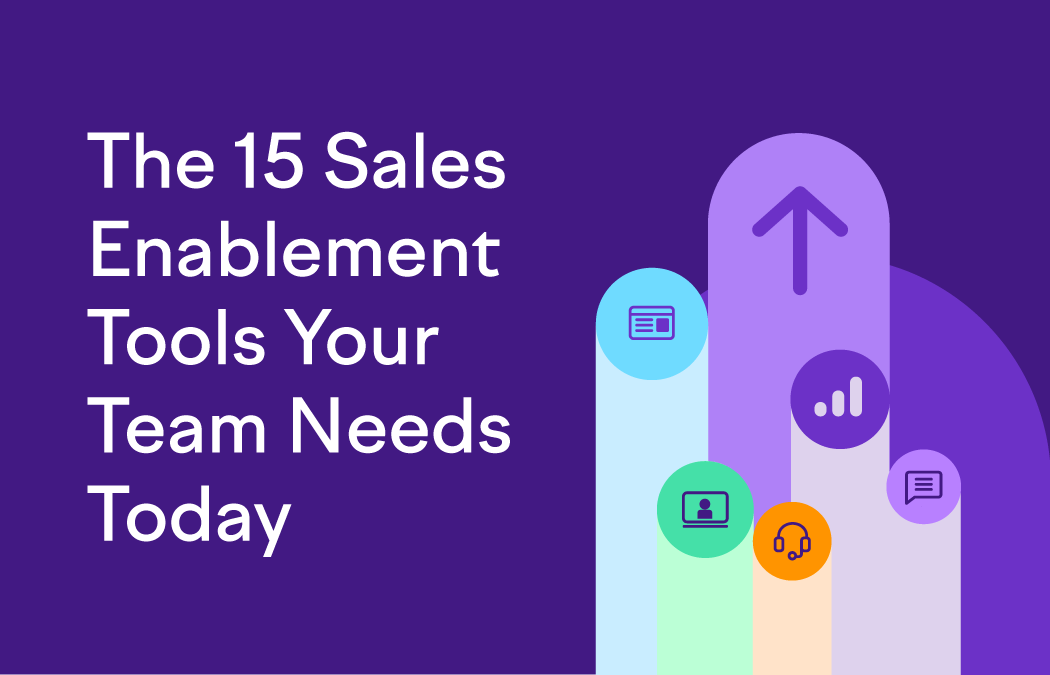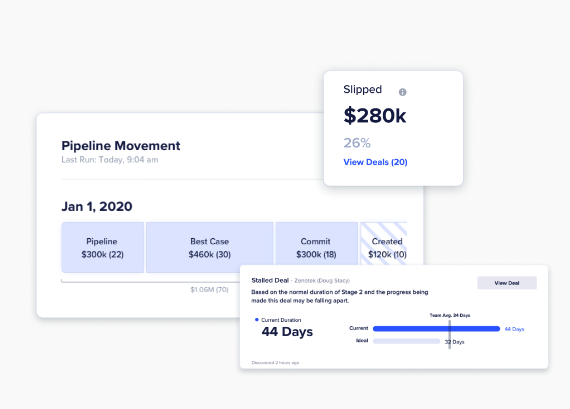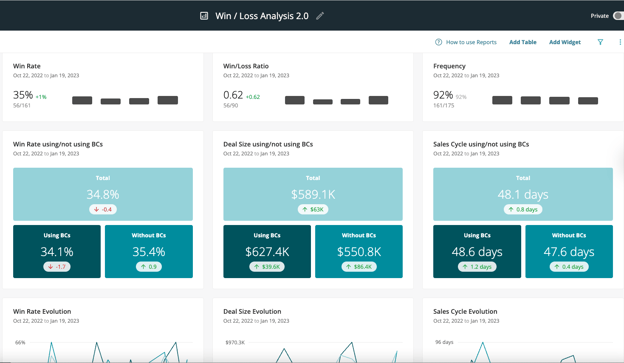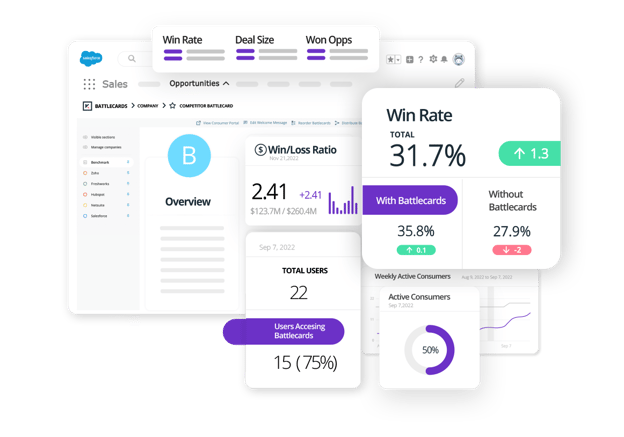Winning the Sales Battle with Battlecards
What is a sales Battlecard, how do salespeople use them, and what should they include? Read on for everything you need to know about an effective...
Sales enablement programs thrive when they're powered by the best tools for your specific needs. Find the tools your team needs to maximize sales potential.

Sales enablement is a critical aspect of any business's growth strategy. It involves providing sales teams with the training, resources, and tools to sell more effectively.
However, with so many sales enablement tools available, it can be difficult to decide which ones your team needs. So in this article, we will explore sales enablement software options and what to consider when choosing the best ones for your specific goals.
Sales enablement tools include any type of software or platform that helps sales teams sell more effectively. These tools can include everything from customer relationship management (CRM) systems to competitive intelligence automation tools to sales training platforms.
When creating a sales enablement strategy, it's essential to consider what tools to use and which are the best for your goals.
For example, if your goal is to increase sales by 10%, consider tools that help with lead generation and conversion rate. If your goal is to improve customer satisfaction, think about tools that help with customer relationship management and communication.
A sales enablement strategy is a plan that outlines how to achieve specific sales goals. Along with your goals and plans to reach them, It should include a list of tools your team needs, their use cases, and who will use them. It should consist of metrics for measuring success and a plan for adjusting the strategy when goals aren’t met.
There are likely hundreds of sales enablement tools, and the number of tools continues to grow as technology advances. Some popular categories of sales enablement tools and individual solutions include:
That’s right. CRM systems serve as a sales enablement tool because they provide sales teams with a centralized location to store and manage customer data. This data can then identify sales opportunities, track customer interactions, and forecast sales.
Priority level: High, as CRM systems are essential for managing and monitoring customer interactions and identifying sales opportunities.
Potential cost: Roughly between $10-$210 per month.
Complexity to learn: Depends on the CRM system chosen, with some being more user-friendly and intuitive than others.
Best for: Businesses of all sizes looking for a comprehensive CRM solution with various sales enablement tools.
Where to start, depending on your goals: Salesforce Sales Cloud for managing leads and automating sales processes, Salesforce Marketing Cloud for managing marketing campaigns, and Salesforce Service Cloud for managing customer support and service.
Best for: Small to medium-sized businesses looking for an all-in-one platform that combines CRM, marketing, and sales tools.
Where to start, depending on your goals: HubSpot CRM for managing leads and customer interactions, HubSpot Sales for automating sales processes, and HubSpot Marketing for managing marketing campaigns.

Sales automation tools are software or platforms that help automate repetitive and time-consuming tasks in the sales process, such as lead tracking and follow-up. This can help increase efficiency and productivity for sales teams.
Priority level: High, as sales automation tools can help increase efficiency and productivity for sales teams.
Potential cost: Roughly between $9.99-$975 per month. Some may be as much as $25,000 per year.
Complexity to learn: This can vary depending on the sales automation tool chosen, with some being more user-friendly and intuitive than others.
Best for: Sales teams looking for a comprehensive sales engagement platform with various automation features, such as email and call tracking, lead management, and automated sales sequences.
Where to start, depending on your goals: Outreach's lead management and prioritization features for identifying and focusing on the hottest leads, and the email and call tracking features for monitoring customer engagement.
Best for: Sales teams looking for a sales automation tool that focuses on email tracking, calendar integration, and automated sales sequences.
Where to start, depending on your goals: Yesware's email tracking and automated sales sequences are great for monitoring customer engagement and automating follow-up tasks.
Competitive intelligence tools let you know when your competitors update their products, pricing, marketing strategies, job postings, and much more. This information can improve sales strategies and help you stay ahead of the competition.
In fact, competitive intelligence is a massive part of the sales enablement strategy. It helps speed up onboarding, track Battlecard use, and understand your SWOT (and that of your competitors so you can overcome objections). They can cut down on call preparation time by hours, too.
Priority level: High, as competitive intelligence tools can provide valuable insights and help businesses improve their sales strategies and stay ahead of the competition. Many sales leaders don’t realize how many deals they lose to competitors until they start win/loss analysis.
Potential cost: Anywhere between $19.99 per month to as high as $75K a year, depending on the tool, use case, and company size.
Complexity to learn: Varies depending on the competitive intelligence tool chosen, with some being more user-friendly and intuitive than others. Many competitive intelligence tools offer tutorials, training materials, and customer support to help users navigate the system.
Best for: Businesses looking for a comprehensive competitive intelligence platform to help track competitors, find key insights, and improve sales strategy.
Where to start, depending on your goals: Kompyte's competitor tracking and analytics features for monitoring competitors' actions and progress, and the reporting tools for tracking your progress and making data-driven decisions.
Win/loss analysis can help you see where your sales team needs extra support. Battlecards and reports are easily accessible in the other sales tools your team is using (HubSpot and Salesforce), meaning they won’t have to adopt yet another tool in order to quickly prepare for sales calls and keep their messaging consistent.

Watch your win rates improve (we usually see an average of up to 30%) with Kompyte Win/Loss Analysis
Special note: Here at Kompyte, we're pretty proud of our features and benefits—and our customers agree. Our Battlecards (including objection-handling Battlecards), platform integrations (Slack, Teams, HubSpot, etc.), real-time insights, competitor analysis reports, and user-submitted insights are unmatched. If you’ve never used Battlecards or playbooks in your sales calls, check out this template.

Sales call recording systems allow sales leaders to monitor calls, watch for proper messaging, and provide opportunities for coaching. Sales reps can use them to critique their own performance and learn from more successful colleagues. Marketing teams may also review calls to get to know customers better and see what positioning resonates best.
Priority level: High. Without this look into actual sales calls, you really don’t know what people are saying, why they’re losing, and if a particular customer is becoming a bigger threat.
Potential cost: There’s a wide range here with prices starting under $10/month per user to well over $100/user per month.
Complexity to learn: Using basic call recording, transcription, and review features is simple, but some of these tools are incredibly powerful and may take a while to master.
Best for: Larger businesses who will make extensive use of Gong for sale, customer success, AND marketing teams as Gong is priced at the higher end of the options because of its impressive feature range.
Where to start, depending on your goals: Start with call recording and coaching to improve the success of your sales team. But make sure your team will use other features as well.

Best for: Sales leaders and others looking to achieve better sales forecasting and results. Make sure your leadership and marketing teams are aware of features that will help them with messaging, too.
Where to start, depending on your goals: Use Chorus to ramp up new sales reps and identify where you’re losing deals.
Best for: Smaller sales teams looking for basic call recording, meeting management, and some cool AI features that include the ability to extract key notes and import into your CRM.
Where to start, depending on your goals: Use Avoma’s transcripts and up to 4x speed playback capability to review calls for coaching opportunities.
Sales content management systems are software or platforms that help sales teams manage and distribute content, such as sales presentations and product information. They can also track the performance of the content and provide analytics to help improve sales strategies.
Priority level: Medium, as sales content management systems can help sales teams effectively manage and distribute content, track performance, and improve sales strategies. This feature may also be available in some other tools (like Kompyte).
Potential cost: About $6-55 per month.
Complexity to learn: Depends on the Sales Content Management System chosen, with some being more user-friendly and intuitive than others. Many sales content management systems offer tutorials, training materials, and customer support to help users navigate and fully use the system.
Best for: Smaller teams with infrequent updates who need an effective way to store and manage sales assets that isn’t on Google Drive.
Where to start, depending on your goals: Keeping sales presentations, one-sheeters, Battlecards, and reports organized is key to consistency in messaging and process. If you can keep your most-recent versions of documents here, it eliminates a lot of headaches. It’s also easy to make collections that can be shared with prospects.
Best for: Businesses looking for a comprehensive sales enablement platform that includes content management, sales training, and analytics features.
Where to start, depending on your goals: Seismic's content management and analytics features for managing and tracking the performance of sales content and identifying areas for improvement, and the sales training features for improving sales team performance.
These tools provide training and development resources that can improve sales skills and keep the team up-to-date with the latest sales trends. We consider them a medium priority as there are other ways to accomplish sales training.
Priority level: Medium, as sales training platforms can provide valuable training and development resources to improve sales skills and knowledge.
Potential cost: Anywhere between $14.50-$97 per month. Some are about $1,000 a year.
Complexity to learn: Depends on the sales training platform chosen, with some being more user-friendly and intuitive than others.
Best for: Businesses with mobile sales teams looking for a way to provide training materials on the go—even in areas with poor connectivity.
Where to start, depending on your goals: Brainshark's mobile-friendly platform for delivering training materials to mobile sales teams and the analytics features for tracking and measuring the performance of sales training.
Best for: Businesses looking for a comprehensive training platform that supports company-wide training initiatives, including sales training.
Where to start, depending on your goals: LearnCore's sales training resources and analytics features for improving sales skills and processes, and the coaching and training program management features for managers.
Think of these as data-centric tools that encompass all the ins and outs of every sale. Sales teams can use them to set goals better, improve internal processes, and forecast future sales.
Priority level: High, as analytics platforms can provide valuable insights and data to help sales teams set goals, improve internal processes, and forecast future sales.
Potential cost: Between $9.99-$445.50 per month. Some can be as much as $9,000 per year.
Complexity to learn: Varies depending on the analytics platform chosen, with some being more user-friendly and intuitive than others.
Best for: Businesses looking for a visual analytics platform can provide detailed information and intuitive explanations to empower organizations to make the most of their data.
Where to start, depending on your goals: Build a dashboard to show current deal stages and the performance of each sales rep at every deal stage.
Best for: Businesses looking for a business intelligence and analytics platform that allows teams to share and explore data with ease via a web-based interface.
Where to start, depending on your goals: Looker's web-based interface for easy data sharing, exploration, and dynamic dashboard features necessary for data-driven decisions.
Finally, sales communication tools are also essential for sales teams looking to communicate more effectively with customers. They’re essential for sales teams looking to streamline communication and increase efficiency.
Priority level: Low, as sales communication tools can be important but not essential for sales teams looking to communicate more effectively with customers as email and other forms of research don’t always require a special tool and your CRM may be the best place to keep all your communications.
Potential cost: It ranges between $3.35 and $399 per month.
Complexity to learn: Depends on the sales communication tool chosen, with some being more user-friendly and intuitive than others.
Best for: Businesses looking for a cloud-based communication platform that offers features such as call forwarding, extensions, directories, call auto-attendants, and more.
Where to start, depending on your goals: RingCentral's call forwarding, extensions, and auto-attendants for enhancing communication and efficiency for sales teams, and its directories for easy contact access.
We included HubSpot in the CRM tools section above, but it’s worth repeating, as a sales-focused CRM like HubSpot can be an invaluable tool for scheduling appointments, communicating via email, and tracking results.
Best for: Small to medium-sized businesses looking for an all-in-one platform that combines CRM, marketing, and sales tools.
Where to start, depending on your goals: HubSpot CRM for managing leads and customer interactions, HubSpot Sales for automating sales processes, and HubSpot Marketing for managing marketing campaigns.
These tools let you find the right buyer personas for your team’s specific goals, hence making sales a touch easier. This knowledge allows managers to make informed decisions about what products they sell, how they sell them, and to whom.
Priority level: Medium, as sales intelligence tools are essential for sales teams looking for the right buyer personas. When it comes to selling, making informed decisions is essential.
Potential cost: Roughly between $29 and $750 per month. Some are $12,000 per year.
Complexity to learn: Varies depending on the tool, some Sales Intelligence tools may be more user-friendly and intuitive than others, but most offer instructional materials to help users get started.
Best for: B2B sales teams looking for a tool to provide contact information for prospects and existing clients.
Where to start, depending on your goals: ZoomInfo's lead generation and contact information search features for finding and reaching out to potential customers, and the analytics and reporting features for tracking and measuring performance.
Best for: B2B SaaS companies looking for a tool that can provide effective targeting and personalized outreach for sales teams.
Where to start, depending on your goals: LinkedIn Sales Navigator's lead generation and account targeting features for identifying and reaching out to potential customers, and the analytics and reporting features for tracking and measuring performance.
Since sales enablement is crucial to the success of your sales team and the company as a whole, it’s vital to provide the necessary tools. Which categories of tools you’ll need depends on where you are in your sales enablement journey, and there are individual solutions to fit every budget and sales strategy.
If you’d like to see how Kompyte in particular can help you close more deals (up to 30% more!), we’d love to hear from you.
What is a sales Battlecard, how do salespeople use them, and what should they include? Read on for everything you need to know about an effective...
Discover the 9 essential Sales Battlecards every sales team needs, with examples and tips on using ChatGPT to gather the information you'll need.
Discover how ChatGPT can revolutionize your sales call preparation process, transforming you into a selling machine. Streamline each step of your...
Be the first to know about new B2B SaaS Marketing insights to build or refine your marketing function with the tools and knowledge of today’s industry.